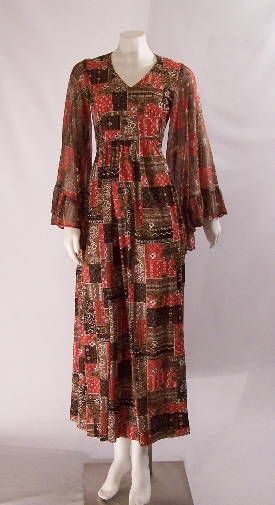|
Tau Robe
A tau robe is a very simple black or white gown cut to resemble the Greek letter, "tau," or "T".Kraig (1989), p. 27. Description The arms are usually from fingertip to fingertip, and the bottom hem is usually floor length, as with a ceremonial tabard.Greer (1998), p. 130–131. Both the arms and body of the gown will flare so that the sleeves being bell sleeve A bell sleeve can be either long or short and is usually set smoothly into the armscye (no pleating or shirring) and flares toward the bottom. Bell sleeves end anywhere from the elbow to the wrist. Flared sleeves ending at the upper bicep are si ...s, are wider at the fingers than at the shoulder, and the bottom wider than at the chest. This loose fitting helps with maneuverability while wearing the robe.Greer (1998), p. 131. Purpose The robe is one of the vestments worn in ceremonial magic. Although not essential, Donald Kraig describes the purpose of wearing the robe as "to physically show both your conscious and your ... [...More Info...] [...Related Items...] OR: [Wikipedia] [Google] [Baidu] |
Tabard
A tabard is a type of short coat that was commonly worn by men during the late Middle Ages and early modern period in Europe. Generally worn outdoors, the coat was either sleeveless or had short sleeves or shoulder pieces. In its more developed form it was open at the sides, and it could be worn with or without a belt. Though most were ordinary garments, often work clothes, tabards might be emblazoned on the front and back with a heraldry, coat of arms (livery), and in this form they survive as the distinctive garment of Officer of Arms, officers of arms. In modern British English, British usage, the term has been revived for what is known in American English as a Apron#Tabard, cobbler apron: a lightweight open-sided upper overgarment, of similar design to its medieval and heraldic counterpart, worn in particular by workers in the catering, cleaning and healthcare industries as Personal protective equipment, protective clothing, or outdoors by those requiring high-visibility clo ... [...More Info...] [...Related Items...] OR: [Wikipedia] [Google] [Baidu] |
Bell Sleeve
A bell sleeve can be either long or short and is usually set smoothly into the armscye (no pleating or shirring) and flares toward the bottom. Bell sleeves end anywhere from the elbow to the wrist. Flared sleeves ending at the upper bicep are similarly shaped, but are instead called butterfly sleeves. The effect is reminiscent of a bell in its shape. If the sleeve is relatively full in circumference and is gathered or pleated into both the armhole and at the bottom, it is called a Bishop's Sleeve. History Bell sleeves were originally found on a garment called a chasuble, which was the dress of clergymen during Medieval times. The religious association of these sleeves eventually dissipated at which point the bell sleeve became adapted by the upper class. In the 1500s, the rich began to stylize the bell sleeve by making them more dramatic in size and more elaborate in decor. The trend of this sleeve made its way from the elite of France to England, where this style really too ... [...More Info...] [...Related Items...] OR: [Wikipedia] [Google] [Baidu] |
Llewellyn Worldwide
Llewellyn Worldwide (formerly Llewellyn Publications) is a New Age publisher based in Woodbury, Minnesota. Llewellyn's mission is to "serve the trade and consumers worldwide with options and tools for exploring new worlds of mind & spirit, thereby aiding in the quests of expanded human potential, spiritual consciousness, and planetary awareness." History Llewellyn Publications was formed in 1901 by Llewellyn George in Portland, Oregon. At first the company concentrated exclusively on astrology, in the form of both books and annuals. Later, Llewellyn began to branch out into other New Age topics such as alternative healing, psychic development, and earth-centered religions, among others. In 1920 Llewellyn Publications moved from Portland to Los Angeles, California. George died in 1954 and the company was bought by Carl L. Weschcke in 1961, who then moved the headquarters to St. Paul, Minnesota. During the 1960s and 1970s, Llewellyn published books from authors such as Dion Fortu ... [...More Info...] [...Related Items...] OR: [Wikipedia] [Google] [Baidu] |
Ceremonial Clothing
Ceremonial dress is clothing worn for very special occasions, such as coronations, graduations, parades, religious rites, trials and other important events. In the western dress code hierarchy of dress codes, ceremonial dress is often considered one of the most formal, in other cultures ceremonial dresses vary widely having entirely different meanings, and styles. Examples There has been documented knowledge on the effects of ceremonial clothing, with those wearing ceremonial clothing have been used to denote a wide range of usage among varying unique cultures. Examples of ceremonial dress include: * royal cloak ( ermine lined), crown and scepter of a monarch * court dress, such as the robe and wig worn by British judges * diplomatic uniform * the full dress uniforms of military personnel (or ceremonial suit of armour) * religious clothing, such as liturgical vestments * folk costume or tribal reserved for the most formal occasions * academic dress * Wedding clothing, including w ... [...More Info...] [...Related Items...] OR: [Wikipedia] [Google] [Baidu] |



